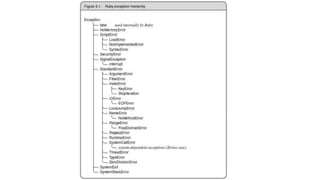Ruby Exceptions
- 2. Array.hello #NoMethodError: undefined method `hello' for Array:Class #from (irb):3 #from /home/vladimir/.rvm/rubies/ruby-1.9.2-p0/bin/irb:17:in `<main>' hello #NameError: undefined local variable or method `hello' for main:Object #from (irb):4 #from /home/vladimir/.rvm/rubies/ruby-1.9.2-p0/bin/irb:17:in `<main>'
- 4. def my_method() raise "SomeError message ..." # raise "m" == raise RuntimeError.new("m") end my_method #exceptions.rb:2:in `my_method': SomeError message ... (RuntimeError) #from exceptions.rb:5:in `<main>'
- 5. class Book attr_accessor :author, :page_count, :title def initialize(args = {}) @author = args[:author] self.page_count = args[:page_count] @title = args[:title] end def page_count=(value) min, max = 1, 1000 if value < min || value > max raise RangeError, "Value of [#{value}] outside bounds of [#{min}] to [#{max}]." else @page_count = value end end end
- 6. begin 100 / 0 rescue puts "F! Divider is zero!" end #=> F! Divider is zero!
- 7. begin some_undefined_method_call rescue NameError puts "F! Undefined method!" end #=>F! Undefined method! def hello(msg = "") raise "Empty message!" if msg == "" puts(msg) rescue puts "Some Error!" end hello("Rubydev.ru") #Rubydev.ru hello #Some Error!
- 8. begin some_undefined_method_call rescue NameError p "F! Undefined method!" ensure p "RubyDev.ru" end #=>"F! Undefined method!" #=>"RubyDev.ru"
- 9. begin 3 / 0 rescue ZeroDivisionError => e puts "#{e.class}: #{e.message}" end begin "my string".odd? rescue NoMethodError => e puts "#{e.class}: #{e.message}" end
- 10. class MyError < StandardError attr_reader :thing def initialize(msg="My default message", thing="apple") @thing = thing super(msg) end end begin raise MyError.new("my message", "my thing") rescue => e puts e.thing # "my thing" end





![class Book
attr_accessor :author, :page_count, :title
def initialize(args = {})
@author = args[:author]
self.page_count = args[:page_count]
@title = args[:title]
end
def page_count=(value)
min, max = 1, 1000
if value < min || value > max
raise RangeError, "Value of [#{value}] outside bounds of [#{min}] to
[#{max}]."
else
@page_count = value
end
end
end](https://image.slidesharecdn.com/rubyexeptions-190306091912/85/Ruby-Exceptions-5-320.jpg)




